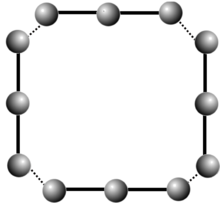
In mathematics, a Lie algebra is a vector space together with an operation called the Lie bracket, an alternating bilinear map , that satisfies the Jacobi identity. In other words, a Lie algebra is an algebra over a field for which the multiplication operation is alternating and satisfies the Jacobi identity. The Lie bracket of two vectors and is denoted . A Lie algebra is typically a non-associative algebra. However, every associative algebra gives rise to a Lie algebra, consisting of the same vector space with the commutator Lie bracket, .
In mathematics, the adele ring of a global field is a central object of class field theory, a branch of algebraic number theory. It is the restricted product of all the completions of the global field and is an example of a self-dual topological ring.
In the mathematical field of representation theory, a weight of an algebra A over a field F is an algebra homomorphism from A to F, or equivalently, a one-dimensional representation of A over F. It is the algebra analogue of a multiplicative character of a group. The importance of the concept, however, stems from its application to representations of Lie algebras and hence also to representations of algebraic and Lie groups. In this context, a weight of a representation is a generalization of the notion of an eigenvalue, and the corresponding eigenspace is called a weight space.
In mathematics, a Lie superalgebra is a generalisation of a Lie algebra to include a Z2‑grading. Lie superalgebras are important in theoretical physics where they are used to describe the mathematics of supersymmetry. In most of these theories, the even elements of the superalgebra correspond to bosons and odd elements to fermions.

In mathematics and theoretical physics, the term quantum group denotes one of a few different kinds of noncommutative algebras with additional structure. These include Drinfeld–Jimbo type quantum groups, compact matrix quantum groups, and bicrossproduct quantum groups. Despite their name, they do not themselves have a natural group structure, though they are in some sense 'close' to a group.
In mathematics, the universal enveloping algebra of a Lie algebra is the unital associative algebra whose representations correspond precisely to the representations of that Lie algebra.

In mathematics, a Lie algebra is semisimple if it is a direct sum of simple Lie algebras..
In mathematics, an affine Lie algebra is an infinite-dimensional Lie algebra that is constructed in a canonical fashion out of a finite-dimensional simple Lie algebra. Given an affine Lie algebra, one can also form the associated affine Kac-Moody algebra, as described below. From a purely mathematical point of view, affine Lie algebras are interesting because their representation theory, like representation theory of finite-dimensional semisimple Lie algebras, is much better understood than that of general Kac–Moody algebras. As observed by Victor Kac, the character formula for representations of affine Lie algebras implies certain combinatorial identities, the Macdonald identities.
In algebraic topology, a Steenrod algebra was defined by Henri Cartan to be the algebra of stable cohomology operations for mod cohomology.

The Lorentz group is a Lie group of symmetries of the spacetime of special relativity. This group can be realized as a collection of matrices, linear transformations, or unitary operators on some Hilbert space; it has a variety of representations. This group is significant because special relativity together with quantum mechanics are the two physical theories that are most thoroughly established, and the conjunction of these two theories is the study of the infinite-dimensional unitary representations of the Lorentz group. These have both historical importance in mainstream physics, as well as connections to more speculative present-day theories.
Verma modules, named after Daya-Nand Verma, are objects in the representation theory of Lie algebras, a branch of mathematics.
In conformal field theory and representation theory, a W-algebra is an associative algebra that generalizes the Virasoro algebra. W-algebras were introduced by Alexander Zamolodchikov, and the name "W-algebra" comes from the fact that Zamolodchikov used the letter W for one of the elements of one of his examples.
A quasi-Hopf algebra is a generalization of a Hopf algebra, which was defined by the Russian mathematician Vladimir Drinfeld in 1989.
In mathematics, the spin representations are particular projective representations of the orthogonal or special orthogonal groups in arbitrary dimension and signature. More precisely, they are two equivalent representations of the spin groups, which are double covers of the special orthogonal groups. They are usually studied over the real or complex numbers, but they can be defined over other fields.
In mathematics, the Butcher group, named after the New Zealand mathematician John C. Butcher by Hairer & Wanner (1974), is an infinite-dimensional Lie group first introduced in numerical analysis to study solutions of non-linear ordinary differential equations by the Runge–Kutta method. It arose from an algebraic formalism involving rooted trees that provides formal power series solutions of the differential equation modeling the flow of a vector field. It was Cayley (1857), prompted by the work of Sylvester on change of variables in differential calculus, who first noted that the derivatives of a composition of functions can be conveniently expressed in terms of rooted trees and their combinatorics.
In mathematics, an algebraic number field is an extension field of the field of rational numbers such that the field extension has finite degree . Thus is a field that contains and has finite dimension when considered as a vector space over .
This is a glossary of representation theory in mathematics.

This is a glossary for the terminology applied in the mathematical theories of Lie groups and Lie algebras. For the topics in the representation theory of Lie groups and Lie algebras, see Glossary of representation theory. Because of the lack of other options, the glossary also includes some generalizations such as quantum group.
In abstract algebra, specifically the theory of Lie algebras, Serre's theorem states: given a root system , there exists a finite-dimensional semisimple Lie algebra whose root system is the given .











































































































































